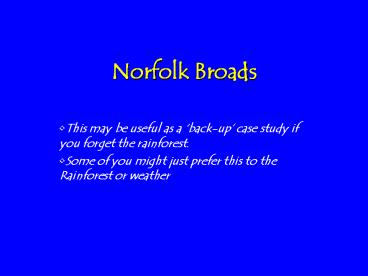Norfolk Broads - PowerPoint PPT Presentation
1 / 12
Title:
Norfolk Broads
Description:
Norfolk Broads. This may be useful as a back-up' case study ... birds on the Broads include Bittern, Coot, Marsh Harrier, Great Crested Grebe and Cormorants. ... – PowerPoint PPT presentation
Number of Views:167
Avg rating:3.0/5.0
Title: Norfolk Broads
1
Norfolk Broads
- This may be useful as a back-up case study if
you forget the rainforest. - Some of you might just prefer this to the
Rainforest or weather
2
By the end of the lesson
- All of you will have remembered the main issues
with the Norfolk Broads case study - Most of you will have made detailed notes on the
Norfolk Broads, and attempted the GCSE exam
question - Some of you will have made detailed notes on the
Norfolk Broads and successfully completed the
GCSE exam question
3
What are the Norfolk Broads?
- What are the Broads?The Norfolk Broads are large
shallow lakes which arose from peat diggings in
mediæval times where mediæval man dug peat for
his fires. They became flooded during the 14th
Century as sea levels rose. In all there are 40
Broads which vary in size. Each Broad has its own
character and most are linked by rivers and
channels creating a total of 120 miles of
waterways.
4
Where are the Norfolk Broads?
5
Why are the Norfolk Broads a popular tourist
destination?
Explain this using the picture to help
you. Answer in the box on the sheet
6
Wildlife at the Broads
- The Broads are famous for wildlife providing
unique habitats unrivalled anywhere in Britain -
ducks, geese and swans are everywhere and there's
no shortage of herons. Up to 100 pairs of Herons
nest in Broadland each year. Other birds on the
Broads include Bittern, Coot, Marsh Harrier,
Great Crested Grebe and Cormorants. Watch out for
bearded tits or a marsh harrier, the Norfolk
Aeshna - a big brown dragonfly and the plants
Marsh Sowthistle and Milk Parsley which grows
nowhere else in Britain.
7
Are the Norfolk Broads a natural ecosystem?
- The answer is
- Sort of!
- They were of course formed when mediaeval man dug
out the peat bogs (artificial) - But they are inhabited by a vast array of
wildlife (natural)
8
What are the major issues?
- Vegetation succession (see handout)
- Eutrophication (see separate PowerPoint)
- How people are using the ecosystem e.g. Boats,
sewage, fertiliser - Man Created the Broads. Is Man destroying it
too?
9
Recap on Vegetation succession and Eutrophication
Press escape, then double click this to see
another PowerPoint
10
Case Study Card
11
Case Study Card
-
Conclusions _____________________________________
__________________________________________________
__________________________________________________
__________________________________________________
__________________________________________________
__________________________________________________
__________________________________________________
___________________________
12
Your task over Easter
- Be realistic with yourself
- Youve got 5 weeks after Easter until your exams
begin - Youve got at least 8 subjects to revise for
- Start to go over the notes weve made so far, and
read through your old exercise books
Complete the exam paper questions you have been
given Try to have a go at completing it in time
limit given































